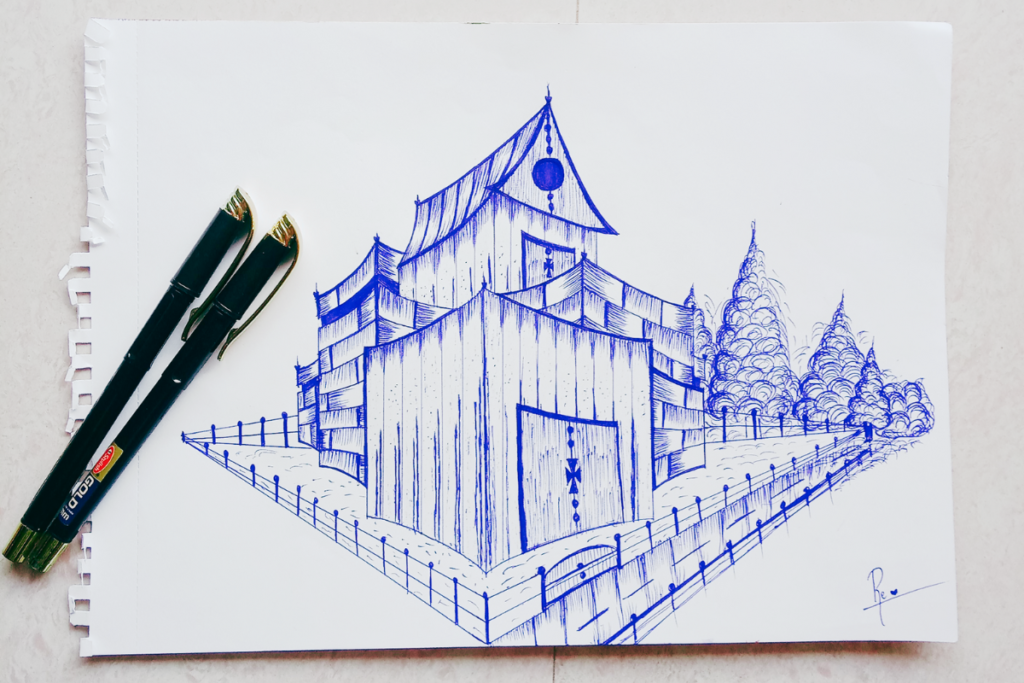Understanding perspective is a game-changer when you dive into sketching. Among the various techniques, 2 point perspective sketches stand out. Their versatility is not just a feature, it’s an invitation to explore and create. They add depth and realism to your drawings, but they also open up a world of creative possibilities.
So, join HTC News for an artistic escapade as we learn how to sketch better realistic drawings in the future.

What are 2 Point Perspective Sketches?
Imagine you’re standing at the corner of a street, looking at two converging roads. This is the essence of 2 point perspective sketches. In this technique, objects are drawn with two vanishing points on the horizon line. These vanishing points help create a sense of depth, making your sketches appear more lifelike.
Why 2 Point Perspective Sketches?
2 point perspective sketches are not just another technique. They are crucial because they reflect how we perceive the world. When you sketch using this method, you can create realistic urban scenes, buildings, and interiors. It’s not just a skill, it’s a commitment to bringing your drawings to life.
Getting Started with 2 Point Perspective Sketches
Before sketching, you’ll need essential tools: a ruler, pencils, an eraser, and paper. Here’s a step-by-step guide to help you begin.
Step 1: Draw the Horizontal Line
Start by sketching a horizontal line across your paper. This line represents the viewer’s eye level. Place two points on this line, ideally towards the edges of your paper. These are your vanishing points.
Step 2: Draw the Main Subject
Draw a vertical line between the vanishing points. This line will be the closest edge of your object. It could be the corner of a building or any subject you’re drawing.
Step 3: Connect to Vanishing Points
Draw lines extending to both vanishing points from the top and bottom of your vertical line. These lines will serve as guides for the sides of your object. Repeat this process for the other vanishing point.
Step 4: Define the Object’s Edges
Draw vertical lines between the guidelines to complete the sides of your object. These lines should be parallel to your initial vertical line. Your object should now start taking shape.
Step 5: Add Details
Erase unnecessary guidelines and add details to your object. Notice how other elements in your scene align with the vanishing points. This consistency ensures your sketch maintains its realistic perspective.
Common Mistakes in 2 Point Perspective Sketches and How to Avoid Them
Mistake 1: Misaligned Vanishing Points
Ensure your vanishing points are positioned correctly. If they’re too close, your object might look distorted. Place them far apart for a more natural look.
Mistake 2: Inconsistent Lines
Always use a ruler for straight lines. Freehand lines can ruin the precision needed for two-point perspective sketches. The use of a ruler ensures that your lines are straight and parallel, which is crucial for maintaining the realism and accuracy of your perspective.
Mistake 3: Ignoring the Horizontal Line
Your horizon line should always represent the viewer’s eye level. Any deviation can disrupt the perspective of your entire sketch.
2 Point Perspective Drawing Examples
Seeing examples can be incredibly helpful. Let’s explore some stunning two-point perspective sketches to inspire you.
Example 1: Urban Street Scene
In this sketch, the artist captures a bustling street corner with buildings receding towards two vanishing points. The details in windows, doors, and signs add depth and realism. Notice how the lines converge neatly at the vanishing points, creating a cohesive scene.
Example 2: Interior Room
This interior sketch uses 2 point perspectives to showcase a room with furniture, windows, and decorations. The furniture’s alignment with the vanishing points gives the room a spacious and realistic feel. You can see how even the smallest details, like picture frames, adhere to the perspective rules.
Example 3: Futuristic Cityscape
A more advanced example, this futuristic cityscape demonstrates how 2 point perspective can be used creatively. The towering buildings and intricate details draw the viewer’s eye into the scene. The precision of the perspective lines makes the sketch both complex and visually appealing.
(more HTC News General Topics)
Tips on How to Draw 2 Point Perspective Sketches
Like any skill, mastering 2 point perspective sketches takes practice. Here are some tips to help you improve.
Tip 1: Start Simple
Begin with basic shapes like cubes and rectangular prisms. Once you’re comfortable, move on to more complex structures.
Tip 2: Use Reference Images
Study photographs or other artists’ sketches to understand how 2 point perspective works in real life. Then, try replicating these images to hone your skills.
Tip 3: Consistent Practice
Set aside time each day to practice. Consistency is critical to improving your technique and building confidence in your sketches.
Advanced Techniques in Two-Point Perspective
Once you’ve mastered the fundamentals, you can experiment with advanced techniques to enhance your sketches.
Adding Multiple Objects
Try adding several objects to your scene, ensuring each adheres to the vanishing points. This will create a more energetic and exciting composition.
Incorporating Shadows and Lighting
Knowing how light interacts with objects can add another layer of realism to your sketches. Use shadows to enhance depth and make your scenes more compelling.
Experimenting with Curves
While the 2 point perspective is typically used for straight lines, you can experiment with curves and irregular shapes. This adds variety and can make your sketches stand out.
Tools and Resources for Improvement
To continue improving, you should explore various tools and resources available.
Online Tutorials
Websites like YouTube and educational platforms offer countless tutorials on 2 point perspective sketches. These can provide new techniques and tips from experienced artists.
Art Books
Invest in art books that focus on perspective drawing. They often include detailed instructions and examples to guide you.
Art Classes
Consider taking an art class, either online or in person. A structured learning environment can provide valuable feedback and accelerate your progress.
Conclusion: Your Journey in Two-Point Perspective
Mastering 2 point perspective sketches opens up a world of possibilities in your artwork. It adds depth, realism, and a professional touch to your sketches. Remember, practice is essential. Keep experimenting, learning, and pushing your boundaries. Soon, you’ll create stunning, realistic sketches that captivate and impress.
By following these steps and regularly honing your skills, you’ll find that two-point perspective drawing will become second nature. Happy sketching!
Frequently Asked Questions About 2 Point Perspective Sketches
1. What is a 2 Point Perspective?
2 point perspective is a drawing method in which objects are drawn with two vanishing points on the horizon line. This approach helps design a sense of depth and realism in your sketches.
2. Why should I use 2 Point Perspective in my drawings?
Using 2 point perspective allows you to create more realistic and dynamic scenes, particularly for urban landscapes, buildings, and interior spaces.
3. What tools do I need to start sketching in 2 Point Perspective?
You’ll need essential tools like rulers, pencils, erasers, and paper. These will help you draw precise lines and create accurate perspectives.
4. How do I place the vanishing points in a 2 Point Perspective sketch?
Place the vanishing points far apart on the horizon line, ideally towards the edges of your paper. This placement prevents distortion and helps achieve a natural look.
5. What are common mistakes beginners make with 2 Point Perspective?
Common mistakes include misaligned vanishing points, inconsistent lines, and ignoring the horizon line. These errors can disrupt the perspective and realism of your sketch.
6. Can I use 2 Point Perspective for drawing interiors?
Yes, 2 point perspective is excellent for drawing interiors. It helps create a realistic sense of space and depth, making your room sketches lifelike.
7. How can I practice 2 point Perspective effectively?
Start with simple shapes like cubes and rectangular prisms. Use reference images and practice consistently to improve your skills. Over time, move on to more complex structures.
8. Are there advanced techniques in 2 Point Perspective drawing?
Advanced techniques include adding multiple objects to a scene, incorporating shadows and lighting, and experimenting with curves and irregular shapes to add variety.
9. Where can I find resources to learn more about 2 Point Perspective?
You can find lessons on platforms like YouTube, educational websites, art books focusing on perspective drawing, and online and in-person art classes.
10. How long does it take to master 2 Point Perspective?
The time it takes to master 2 point perspectives varies for each individual. With regular practice and determination, you can see significant improvement in a few months.
read more: The Heartbreaking Story of Aubreigh Wyatt: How Bullying and Social Media Pressure Led to Tragedy


